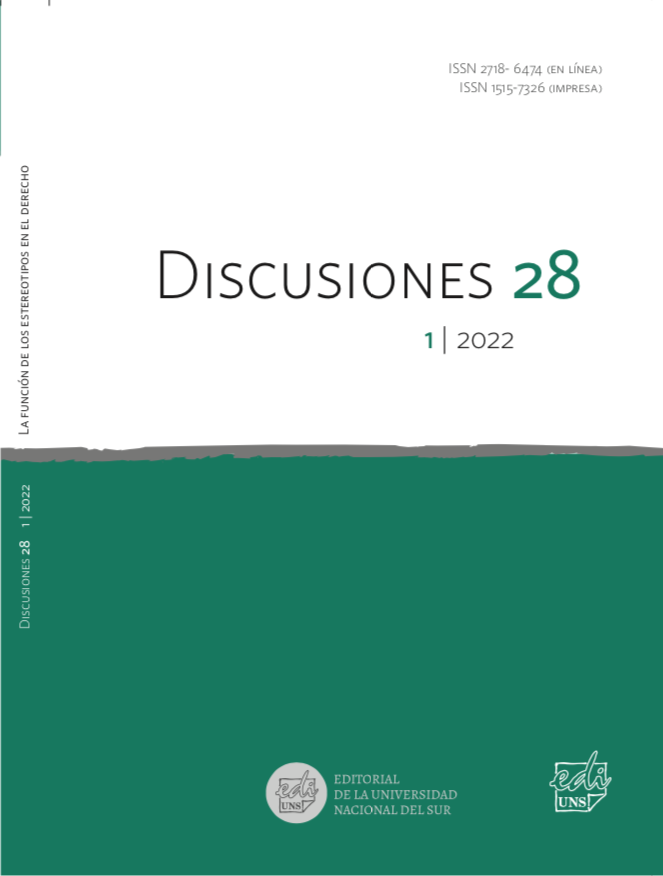Contextual Analysis, Intersectionality and Justificatory Function of Stereotypes in Law: A reply
DOI:
https://doi.org/10.52292/j.dsc.2022.3286Keywords:
Contextual Analysis, Interseccionality, StereotypesAbstract
In this reply we present a response to Lourdes Peroni and Liliana Ronconi’s comments on our text “The role of stereotypes in the forms of complex inequality: some insights from the feminist critique of anti-discrimination law”. First of all, we will try to expose our considerations about contextual analysis, often mentioned in the literature as a key element of an effective anti-stereotyping analysis. We will try to problematize —not demonize— this concept, in order to generate more conceptual clarity and enhance the explanatory capacity of the concept of patriarchy, an essential tool in the approach to the mechanisms of oppression from our theoretical position. Linked to the concept of patriarchy, we will try to specify the contributions of structural intersectionality that are functional to understand stereotypes. Finally, we take this opportunity to further deepen the main argument of our contribution, which is the justifying function of stereotypes.
Downloads
References
Álvarez, S. (2021). Algunas discrepancias sobre el concepto de género, la violencia de género y su relevancia para el derecho. Comentarios a Francesca Poggi, Doxa. Cuadernos de Filosofía del Derecho, 44, 557-585
Añón Roig, M. J. (2013). Principio antidiscriminatorio y determinación de la desventaja. Isonomía, 39(39), 127–157.
Arnardóttir, O. M. (2014). The differences that make a difference: Recent developments on the discrimination grounds and the margin of appreciation under Article 14 of the European Convention on Human Rights. Human Rights Law Review, 14(4), 647–670. https://doi. org/10.1093/hrlr/ngu025
Arena, F. J. (2019). Algunos criterios metodológicos para evaluar la relevancia jurídica de los estereotipos. En V. Risso y S. Pezzano (eds.), Derecho y Control (2) (pp. 11–44).
Barrère, M. Á. (2003). Problemas del Derecho antidiscriminatorio: Subordinación versus Discriminación y acción positiva versus igualdad de oportunidades. Cuadernos Electrónicos de Filosofía Del Derecho, 9, 1–26.
Barrère, M. Á. (2014a). El Derecho Antidiscriminatorio y sus límites. Especial referencia a la perspectiva iusfeminista. Lima: Grijley.
Barrère, M. Á. (2014b). La igualdad de género desde el activismo de las profesiones jurídicas. Revista Vasca de Administración Pública, 99–1001, 513–528.
Bartlett, K. T. (1989). Feminist Legal Methods. Harvard Law Review, 103, 829–888.
Bórquez, N., & Clérico, L. (2021). Una vuelta de tuerca al análisis de estereotipo: estereotipo combinado. Revista Electrónica. Instituto de Investigaciones Ambrosio L. Gioja, 26, 1–28. http://www.derecho.uba.ar/revistas-digitales/index.php/revista-electronica-gioja/article/view/545
Cardoso Onofre de Alencar, E. (2016). Mujeres y estereotipos de género en la jurisprudencia de la Corte Interamericana de Derechos Humanos.
Eunomía. Revista En Cultura de La Legalidad, 26–48. https://e-revistas.uc3m.es/index.php/EUNOM/article/view/2801
Clérico, L. (2018). Hacia un análisis integral de estereotipos: desafiando la garantía estándar de imparcialidad. Revista Derecho Del Estado, 41(May), 67–96. https://doi.org/10.18601/01229893.n41.03
Cook, R. J., & Cusack, S. (2010). Gender stereotyping: Transnational Legal Perspectives. University of Pennsylvania Press.
Crenshaw, K. (1991). Mapping the Margins: Intersectionality, Identity Politics, and Violence Against Women of Color. Stanford Law Review, 43, 1241–1299.
Fenton, Z. E. (1998). Domestic Violence in Black and White: Racialized Gender Stereotypes in Gender Violence. Columbia J. Gender & L., 8(1), 1–65. https://dx.doi.org/10.2139/ssrn.137037
Ghidoni, E. (2021). Developing Structural Intersectionality in Legal Analysis: The Case of Stereotypes as Forms of Discrimination. PhD thesis. Bilbao: University of Deusto.
Ghidoni, E. (2022). Aproximación a los estereotipos como elementos del razonamiento judicial a través de las presunciones. En F. J. Arena (ed.), Manual sobre los efectos de los estereotipos en la impartición de justicia (pp. 287–325). Ciudad de México: Suprema Corte de Justicia de la Nación.
Glick, P., & Fiske, S. T. (2007). Sex Discrimination: The Psychological Approach. En F. J. Crosby, M. S. Stockdale, & A. S. Ropp (Eds.), Sex Discrimination in the Workplace: Multidisciplinary Perspectives (pp. 155–188). Blackwell.
Goldberg, S. B. (2011). Discrimination by Comparison. Yale Law Journal, 120, 728–812. https://scholarship.law.columbia.edu/faculty_ scholarship/978
Hunter, R., McGlynn, C., & Rackley, E. (Eds.). (2010). Feminist Judgements. From Theory to Practice (1st ed.). Hart Publishing.
Lacey, N. (1998). Unspeakable Subjects: Feminist Essays in Legal and Social Theory. Hart Publishing.
Lousada Arochena, J. F. (2020). El enjuiciamiento de género. Madrid: Dykinson.
Matsuda, M. J. (1986). Liberal Jurisprudence and Abstracted Visions of Human Nature: A Feminist Critique of Rawls’ Theory of Justice. New Mexico Law Review, 16(3), 613–630. https://digitalrepository.unm.edu/ nmlr/vol16/iss3/18
McCrudden, C. (2011). Introduction. Thinking the Unthinkable? European Gender Equality Law Review, 1, 3–5. https://www.equalitylaw.eu/ downloads/2796-european-gender-equality-law-review-1-2011
Minow, M., & Spelman, E. V. (1990). In Context. Southern California Law Review, 63, 1597–1652.
Morondo Taramundi, D. (2014). El principio de igualdad entre mujeres y hombres frente a la prohibición del velo islámico integral. Anuario de Filosofía Del Derecho, XXX, 291–307.
Morondo Taramundi, D. (2021). Desigualdad compleja e interseccionalidad: «reventando las costuras» del derecho antidiscriminatorio. En La Spina, E., Cruz Ayuso, C. y Morondo Taramundi, D. (coord.). Desigualdades complejas e Interseccionalidad. Una revisión crítica (pp. 11-28). Madrid: IISJ-Dykinson.
Peroni, L. (2022). Los Estereotipos en el Derecho Antidiscriminatorio: Comentario. Discusiones, 28(1).
Render, M. (2010). Gender Rules. Yale Journal of Law and Feminism, 22, 133–191. https://scholarship.law.ua.edu/fac_articles/655/
Ronconi, L. (2022). Estereotipos y derecho antidiscriminatorio: algunas reflexiones para desarmar la desigualdad compleja. Discusiones, 28(1).
Schauer, F. (2006). Profiles, probabilities and stereotypes. Cambridge: Belknap Press.
Timmer, A. (2011). Toward an anti-stereotyping approach for the European Court of Human Rights. Human Rights Law Review, 11(4), 707–738. https://doi.org/10.1093/hrlr/ngr036
Undurraga, V. (2016). Gender Stereotyping in the Case Law of the InterAmerican Court of Human Rights. En E. Brems & A. Timmer (Eds.), Stereotypes and Human Rights Law (pp. 67–93). Intersentia. https://doi.org/10.1017/9781780685458.004
Published
Versions
- 2024-09-15 (2)
- 2022-07-04 (1)
How to Cite
Issue
Section
License
Copyright (c) 2022 Elena Ghidoni, Dolores Morondo Taramundi

This work is licensed under a Creative Commons Attribution-NonCommercial 4.0 International License.
Discusiones does not withhold rights of reproduction or copyright. Consequently, authors may share the final versions of publications.


